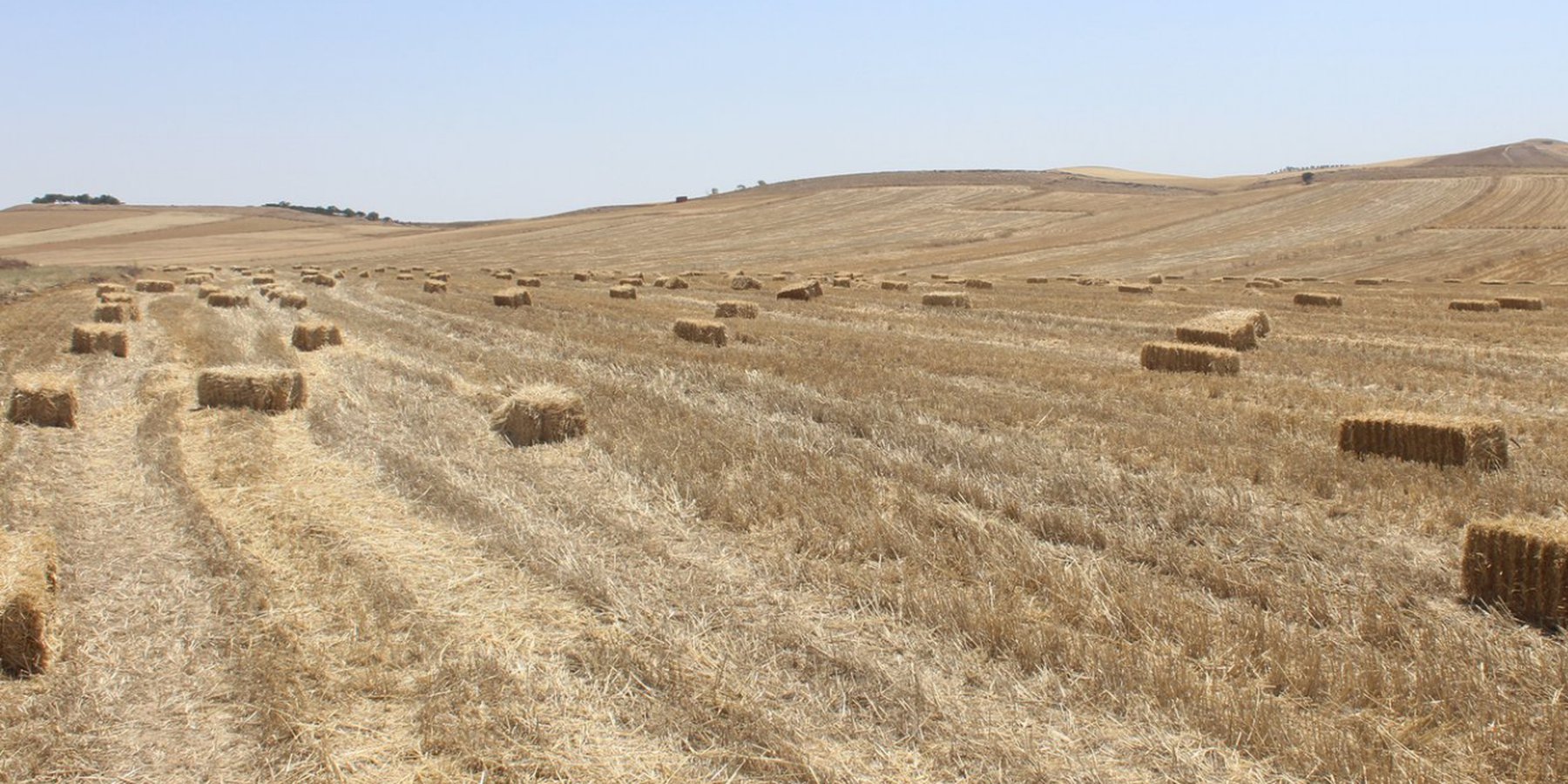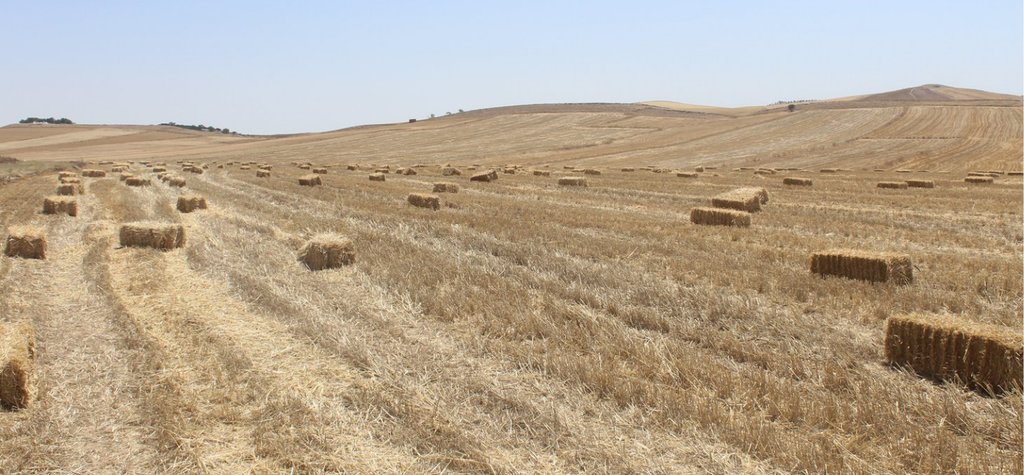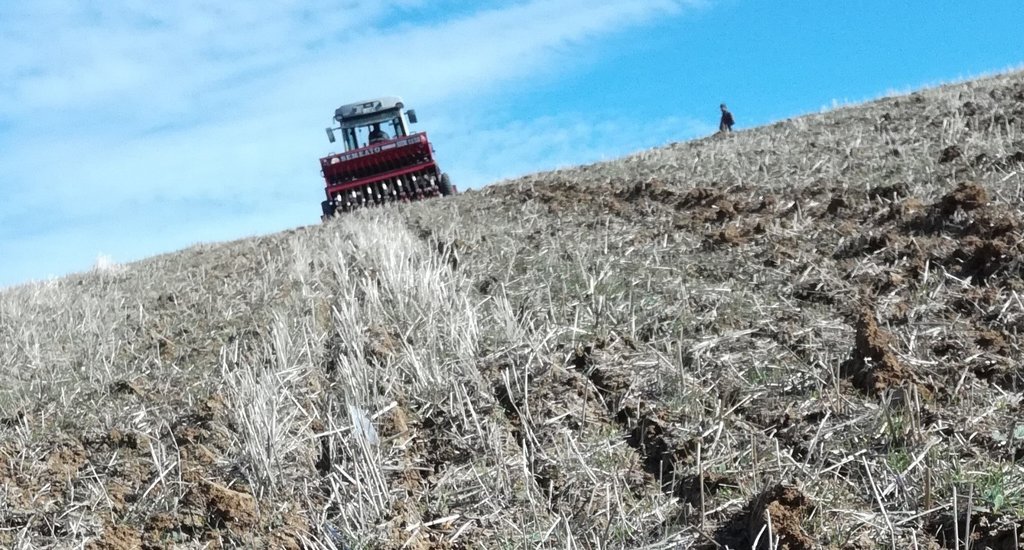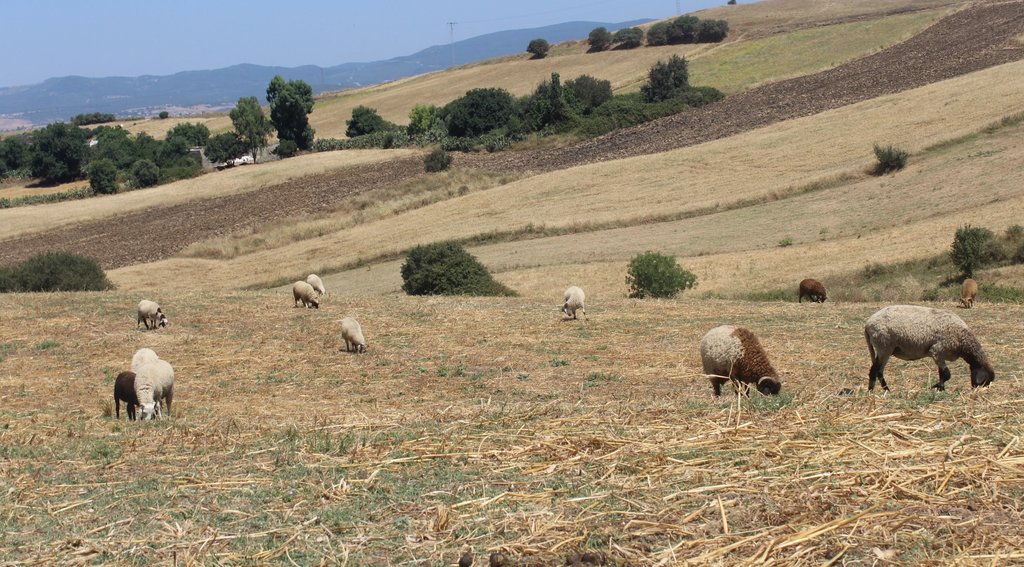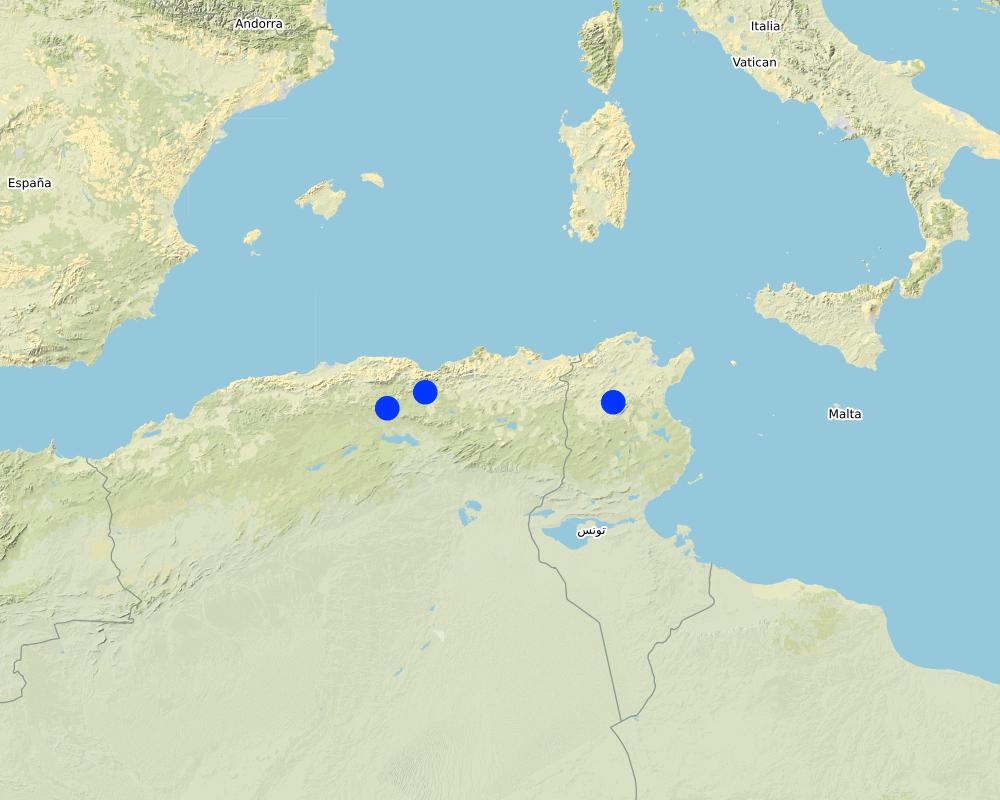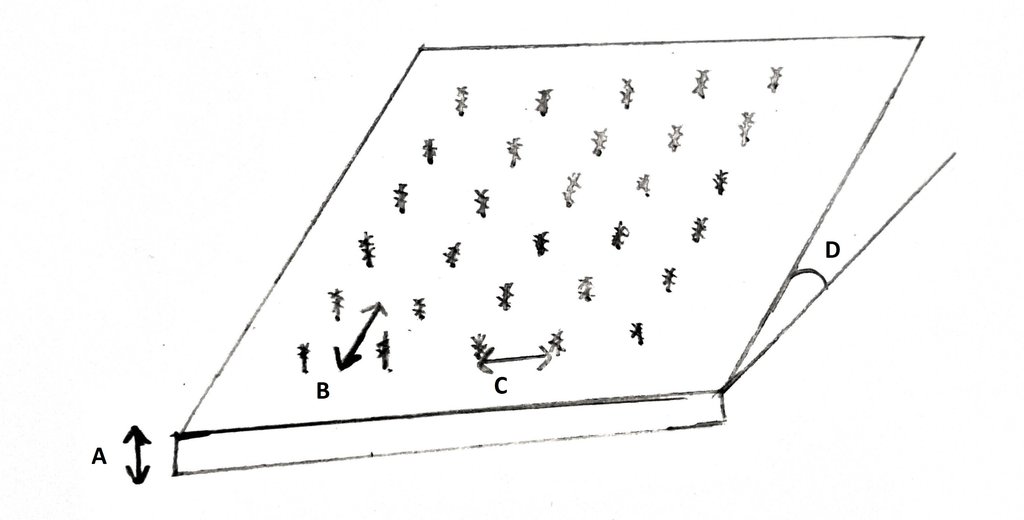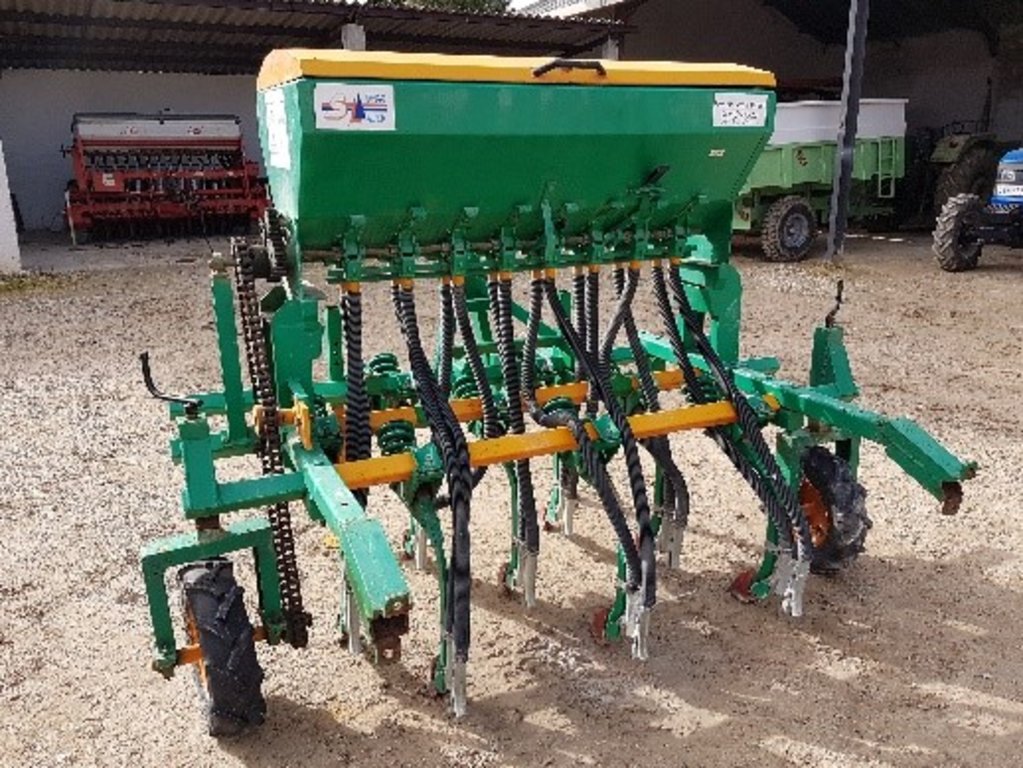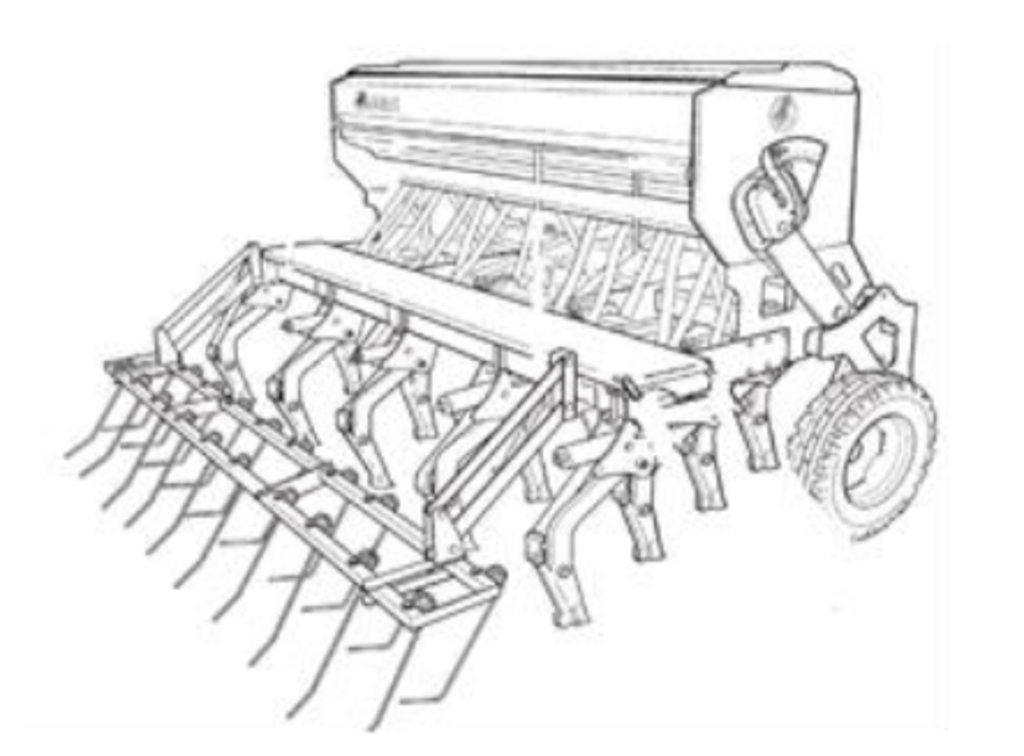Conservation Agriculture in Dryland Mixed Systems
- Création :
- Mise à jour :
- Compilateur : Joren Verbist
- Rédacteur : –
- Examinateur : Rima Mekdaschi Studer
technologies_5819
Voir les sections
Développer tout Réduire tout1. Informations générales
1.2 Coordonnées des personnes-ressources et des institutions impliquées dans l'évaluation et la documentation de la Technologie
Personne(s)-ressource(s) clé(s)
Senior Livestock Scientist:
Rekik Mourad
International Center of Agriculture Research in the Dry Areas (ICARDA)
Tunisie
Agronomist:
M'hamed Cheikh Hatem
National Institute of Agricultural Research of Tunisia (INRAT)
Tunisie
Scaling Specialist:
Idoudi Zied
International Center of Agriculture Research in the Dry Areas (ICARDA)
Tunisie
Nom du projet qui a facilité la documentation/ l'évaluation de la Technologie (si pertinent)
ICARDA Institutional Knowledge Management InitiativeNom du ou des institutions qui ont facilité la documentation/ l'évaluation de la Technologie (si pertinent)
International Center for Agricultural Research in the Dry Areas (ICARDA) - Liban1.3 Conditions relatives à l'utilisation par WOCAT des données documentées
Le compilateur et la(les) personne(s) ressource(s) acceptent les conditions relatives à l'utilisation par WOCAT des données documentées:
Oui
1.4 Déclaration sur la durabilité de la Technologie décrite
Est-ce que la Technologie décrite ici pose problème par rapport à la dégradation des terres, de telle sorte qu'elle ne peut pas être déclarée comme étant une technologie de gestion durable des terres?
Non
2. Description de la Technologie de GDT
2.1 Courte description de la Technologie
Définition de la Technologie:
Conservation Agriculture (CA) is a "ready-to-scale concept" in agriculture that allows a sustainable agricultural production and mitigation of climate change. The documented CA focuses on a dryland mixed system, including a biennial rotation of legume and cereals with integrated livestock management. CA has positive benefits on soil health and significantly reduces the needed inputs (e.g. fuel, labour) and workload for farmers.
2.2 Description détaillée de la Technologie
Description:
Land degradation leading to desertification is an increasingly important problem in the dry land regions of the globe. This does not only affect the bio-physical aspects such as carbon storage, but also the lives of local land users. Land degradation is often initiated by the lack of vegetation cover as is often a consequence of overgrazing and over-ploughing (i.e mismanagement). Furthermore, climate change leads to droughts, intensified rainfall events, increased temperature, and more extreme weather events. These compromised climatic conditions enhance land degradation. This leads to less fertile soils, reducing yields and consequently deteriorates the income and lives of local farmers. Taking the consequence and scale of degradation into account, natural resource conservation interventions are urgently required.
As the lack of soil cover is an, if not the, essential initiating factor in the desertification process, it should be maximally addressed. In the light of this, CA has been developed, based on three leading principles: i) minimizing soil disturbances or no-tillage, ii) maintaining a permanent soil cover with mulch, and iii) adequate crop rotations. Overall, the three principles prevent land degradation and can also rehabilitate the land. This is because soil organic matter is maintained in/on the soil and the erosive power of raindrops are broken by the soil cover. Therefore, CA aims for more sustainable resource use (land and water use) and to optimize climate-resilient and integrated crop-livestock systems to sustainably intensify production in fragile dry areas.
Tunisia is a country that experiences the previously described pattern and results of desertification and where smallholder farmers are largely dependent on livestock for income generation. However, the livestock competes with the concept of CA as plant residues (stubble) are normally grazed by the livestock. Conservation agriculture propagates no or minimum soil disturbance/ tillage. However, the purchase of a zero-tillage seeder machine appears to be a bottleneck due to high costs since they are hardly produced locally. Nevertheless, there are farmers in the semi -arid areas of Tunisia, who adopted the technology and experience significant benefits such as increased soil fertility and over time increasing yields. In addition, as erosion rates are high in this rainfed area of 300 to 600 mm annual precipitation, a well-covered soil will reduce runoff and loss of top soil. Since ploughing is restricted, the workload and the demanded fuel is reduced, resulting in decreased costs and labour with respect to the conventional practices. Furthermore, integrated crop-livestock is practiced by limiting livestock to graze only the freshly harvested fields while producing manure to enhance soil health (organic fertilization and increase in soil organic matter).
Additionally, according to the third principle of CA, legumes were introduced in the agricultural system (crop rotation), besides the conventional cereal (e.g. durum wheat or barley). Specifically, faba bean is promising, as it has nitrogen fixing effects, enhancing soil health, and increasing and diversifying farm income. Vetch and other forage mixtures have also been successfully introduced to provide farmers with nutritious feed for livestock within the CA concept. In irrigated areas (e.g. parts in Algeria), the practice of CA has an additional benefit as it increases the irrigation water use efficiency due to less evaporation and better infiltration.
The previous agro-pastoral farming practices changed under CA to an integrated crop-livestock system where soil cover is permanent. This mixed system consist of firstly weed control. Secondly, zero-tillage seeding is done directly into the soil even if covered with e.g. mulch/stubble. Faba bean and/or wheat are seeded and rotated yearly. This is beneficial as legumes fix nitrogen in the soil, lowering the amount of nitrogenous fertilizer needed. Thirdly, required fertilizers (for wheat additional nitrogenous fertilizer) is applied with a spreader. Fourthly, herbicides, pesticides, insecticides and fungicides are applied with a sprayer for disease control. Fifthly, the field is harvested with a combine. The stubble is then partly grazed by the sheep and goats until there remains a 1-2 cm residue layer i.e. mulch. For one hectare this accounts for a thirty day grazing period for thirty goats or sheep. This results in an integrated Crop-Livestock system under CA (CLCA), as the stubble provides feed for livestock while the livestock provides the soil with manure.
The land users that have adopted CA have indicated that they extremely appreciate the reduction in work, also the cost of labour and fuel, etc. In addition, they saw increased yields due to improved soil health. However, this beneficial impact could only be observed in the long-term since yields take time to increase, which can be considered as a weakness as the small holder farmer tends to prioritize short term profits. Another weakness is that the livestock is constrained since residues ought to remain on the field.
In conclusion, even though there are bottlenecks, the technology of conservation agriculture is a solution to combat desertification while improving the lives of local land users through the process.
Information and data presented is partly made available through the project “Use of conservation agriculture in crop-livestock systems (CLCA) in the drylands for enhanced water use efficiency, soil fertility and productivity in NEN and LAC countries” funded by the International Fund for Agricultural Development (IFAD), managed by the International Center for Agricultural Research in the Dry Areas (ICARDA) and implemented in Tunisia by the National Agricultural Research Institute (INRAT).
2.3 Photos de la Technologie
2.5 Pays/ région/ lieux où la Technologie a été appliquée et qui sont couverts par cette évaluation
Région/ Etat/ Province:
Algeria: M'Sila and Setif; Tunisia: Siliana
Spécifiez la diffusion de la Technologie:
- répartie uniformément sur une zone
S'il n'existe pas d'informations exactes sur la superficie, indiquez les limites approximatives de la zone couverte:
- 100-1 000 km2
Est-ce que les sites dans lesquels la Technologie est appliquée sont situés dans des zones protégées en permanence?
Non
Commentaires:
The land under CA in Tunisia and Algeria is 14 000ha and 5600 ha, respectively. Most of the sites (approximately 70%) are thus located in Tunisia. The regions pinned in the map represent the sites that match the documentation.
Map
×2.6 Date de mise en œuvre de la Technologie
Indiquez l'année de mise en œuvre:
1999
2.7 Introduction de la Technologie
Spécifiez comment la Technologie a été introduite: :
- au cours d'expérimentations / de recherches
- par le biais de projets/ d'interventions extérieures
3. Classification de la Technologie de GDT
3.1 Principal(aux) objectif(s) de la Technologie
- améliorer la production
- réduire, prévenir, restaurer les terres dégradées
- s'adapter au changement et aux extrêmes climatiques et à leurs impacts
- créer un impact économique positif
3.2 Type(s) actuel(s) d'utilisation des terres, là où la Technologie est appliquée
Les divers types d'utilisation des terres au sein du même unité de terrain: :
Oui
Précisez l'utilisation mixte des terres (cultures/ pâturages/ arbres):
- Agropastoralisme (y compris les systèmes culture-élevage intégrés)

Terres cultivées
- Cultures annuelles
Cultures annuelles - Précisez les cultures:
- céréales - blé d'hiver
- légumineuses et légumes secs - fèves
- Faba bean, vetch
Système de cultures annuelles :
Blé ou rotation similaire de foin/pâturage
Nombre de période de croissance par an: :
- 1
Est-ce que les cultures intercalaires sont pratiquées?
Non
Est-ce que la rotation des cultures est appliquée?
Oui
Si oui, veuillez préciser:
Wheat is rotated with other crops (see technicality) such as faba bean or forage crops like vetch.

Pâturages
Pâturage intensif/ production fourragère :
- Affouragement en vert/ zéro-pâturage
- livestock allowed to graze only the freshly harvested fields
Type d'animal:
- caprine
- ovins
Est-ce que la gestion intégrée cultures-élevage est pratiquée?
Oui
Si oui, veuillez préciser:
Crop residues remain on the field. This is allowed for limited grazing by the livestock after harvest (between april and july). The 30-30 rule states that is allowed for a 30 sized flock (sheep or goats) to graze 1 ha for 30 days. Logically, bigger flock means less days and vice versa. While the flock grazes the land it provides the soil with manure. Vetch is cut and carried to feed the livestock.
Produits et services:
- viande
- lait
Espèces:
caprine
Espèces:
ovins
3.3 Est-ce que l’utilisation des terres a changé en raison de la mise en œuvre de la Technologie ?
Est-ce que l’utilisation des terres a changé en raison de la mise en œuvre de la Technologie ?
- Oui (Veuillez remplir les questions ci-après au regard de l’utilisation des terres avant la mise en œuvre de la Technologie)
Les divers types d'utilisation des terres au sein du même unité de terrain: :
Oui
Précisez l'utilisation mixte des terres (cultures/ pâturages/ arbres):
- Agropastoralisme (y compris les systèmes culture-élevage intégrés)

Terres cultivées
- Cultures annuelles
Cultures annuelles - Précisez les cultures:
- céréales - blé d'hiver
Système de cultures annuelles :
Culture continue du blé/de l'orge/de l'avoine/du riz sec
Est-ce que les cultures intercalaires sont pratiquées?
Non
Est-ce que la rotation des cultures est appliquée?
Non

Pâturages
- livestock allowed to graze only the freshly harvested fields
Type d'animal:
- caprine
- ovins
Est-ce que la gestion intégrée cultures-élevage est pratiquée?
Oui
Si oui, veuillez préciser:
livestock allowed to graze on the cereal stubbles left in the field.
Produits et services:
- viande
- lait
Commentaires:
The land use has not necessarily changed as in the previous agro-pastoral system, livestock was also allowed to graze the field, providing it with manure. The difference is that under CA the livestock is not allowed to fully graze the land, leaving a soil cover.
3.4 Approvisionnement en eau
Approvisionnement en eau des terres sur lesquelles est appliquée la Technologie:
- pluvial
3.5 Groupe de GDT auquel appartient la Technologie
- gestion intégrée cultures-élevage
- Amélioration de la couverture végétale/ du sol
- perturbation minimale du sol
3.6 Mesures de GDT constituant la Technologie

pratiques agronomiques
- A1: Couverture végétale/ du sol
- A3: Traitement de la couche superficielle du sol
- A6: Gestion des résidus des cultures
A3: Différenciez les systèmes de travail du sol:
A 3.1: Systèmes de culture sans travail du sol
A6: Précisez la gestion des résidus des cultures:
A 6.5: Résidus retenus

modes de gestion
- M2: Changement du niveau de gestion / d'intensification
Commentaires:
The residues are partly retained and partly grazed.
3.7 Principaux types de dégradation des terres traités par la Technologie

érosion hydrique des sols
- Wt: perte de la couche superficielle des sols (couche arable)/ érosion de surface
- Wg: ravinement/ érosion en ravines

érosion éolienne des sols
- Et: perte de la couche superficielle des sols (couche arable)

dégradation chimique des sols
- Cn: baisse de la fertilité des sols et réduction du niveau de matière organique (non causée par l’érosion)

dégradation physique des sols
- Pk: scellage et encroûtement

dégradation biologique
- Bc: réduction de la couverture végétale
- Bq: baisse de la quantité/ biomasse
- Bl: perte de la vie des sols
- Bp: augmentation des insectes nuisibles (ravageurs)/ maladies, baisse des prédateurs

dégradation hydrique
- Ha: aridification
3.8 Prévention, réduction de la dégradation ou réhabilitation des terres dégradées
Spécifiez l'objectif de la Technologie au regard de la dégradation des terres:
- prévenir la dégradation des terres
- restaurer/ réhabiliter des terres sévèrement dégradées
Commentaires:
The technology of CA prevents land degradation as the soil cover prevents erosion because the cover breaks the erosive power of rainfall and wind. Also, CA has the ability to rehabilitate as the content (like organic matter and carbon) of the soil cover (e.g. mulch/stubble) remains in the soil eventually improving the soil quality.
4. Spécifications techniques, activités, intrants et coûts de mise en œuvre
4.1 Dessin technique de la Technologie
Spécifications techniques (associées au dessin technique):
The row interspace (C) for wheat and faba bean is respectively 17 centimeter and 35 centimeter. The density [plants per square meter] for wheat and faba bean is, respectively, 300-400 and 25. The spacing between crops in the row (B) for wheat and faba bean is, respectively, 1.5-2 centimeter and 11 centimeter. The slopes of the fields (D) vary between 3% and 10%.
For the livestock integration with CA, a flock of thirty (goats or sheep) may graze 1 hectare of stubble for a period of thirty days. This yields optimal trade-off between livestock and soil cover. As soil cover a 1-2 cm residue layer remains (A).
Please note that these values may vary with respect to different terrain, species of plants, flock size, and fertilizer application. For example if a flock contain more sheep or goats, it logically results in less grazing days.
Auteur:
Joren Verbist
Date:
22/12/2020
Spécifications techniques (associées au dessin technique):
The local Tunisian zero-tillage seeder is named Sajir. This machine has better results than imported machines in terms of adjustable and homogeneous sowing depth, high germination rate and similar yield. The design is still changing to the recent and ongoing modifications (e.g. designing and manufacturing a local tine) to be better suitable to Tunisian soil context.
Auteur:
Mohamed Jadlaoui
Date:
01/01/2020
Spécifications techniques (associées au dessin technique):
"Boudour" is a zero-tillage seeder machine used in Algeria.
Its technicality: The loading capacity is 150 kilogram of seeds and 150 kilograms for fertilizer.
The depth can be adjusted and is between 0 and 8 cm. The overall width is 2.8 meter whereas the seed row spacing is 18 centimetres.
The loading height is 154 centimetres.
It is suitable for a 65-76 horsepower tractor.
Auteur:
SOLA
Date:
01/04/2020
4.2 Informations générales sur le calcul des intrants et des coûts
Spécifiez la manière dont les coûts et les intrants ont été calculés:
- par superficie de la Technologie
Indiquez la taille et l'unité de surface:
1 hectare
Indiquez la monnaie utilisée pour le calcul des coûts:
- dollars américains
Indiquez le coût salarial moyen de la main d'œuvre par jour:
5.3
4.3 Activités de mise en place/ d'établissement
| Activité | Calendrier des activités (saisonnier) | |
|---|---|---|
| 1. | Purchase Zero-Tillage Seeder |
4.4 Coûts et intrants nécessaires à la mise en place
| Spécifiez les intrants | Unité | Quantité | Coûts par unité | Coût total par intrant | % des coût supporté par les exploitants des terres | |
|---|---|---|---|---|---|---|
| Equipements | Zero-Tillage Seeder | piece | 1,0 | 20000,0 | 20000,0 | |
| Coût total de mise en place de la Technologie | 20000,0 | |||||
| Coût total de mise en place de la Technologie en dollars américains (USD) | 20000,0 | |||||
Commentaires:
The Zero-Tillage-Seeder can be bought as a community. This would lower the effective cost per farmer. Also, it is possible to hire Zero-Tillage Seeder.
4.5 Activités d'entretien/ récurrentes
| Activité | Calendrier/ fréquence | |
|---|---|---|
| 1. | Weeding (Total weed control) | Year 1 Early-October |
| 2. | Seeding Faba Bean | Year 1 Mid-October |
| 3. | Apply Baseline Fertilization | Year 1 Mid-October |
| 4. | Apply Herbicide | Year 1 Mid-October |
| 5. | Apply Fungicide and Insecticide | Year 1 March-Early April |
| 6. | Limited Grazing/Harvesting | Year 1 Late-April/May |
| 7. | Weeding (Total weed control) | Year 2 Early-November |
| 8. | Seeding Wheat | Year 2 Mid-November |
| 9. | Apply Baseline Fertilization | Year 2 Mid-November |
| 10. | Apply Nitrogenous Fertilization | Year 2 December-January-February |
| 11. | Apply Herbicide | Year 2 December |
| 12. | Apply Fungicide | Year 2 March-April |
| 13. | Limited Grazing/Harvesting | Year 2 Late-June/Early-July |
4.6 Coûts et intrants nécessaires aux activités d'entretien/ récurrentes (par an)
| Spécifiez les intrants | Unité | Quantité | Coûts par unité | Coût total par intrant | % des coût supporté par les exploitants des terres | |
|---|---|---|---|---|---|---|
| Main d'œuvre | Weeding | Person-hour | 1,0 | 100,0 | ||
| Main d'œuvre | Seeding | Person-hour | 2,0 | 100,0 | ||
| Main d'œuvre | Fertilizer Application | Person-hour | 0,5 | 100,0 | ||
| Main d'œuvre | Harvesting | Person-hour | 2,0 | 100,0 | ||
| Equipements | The Zero-Tillage Seeder (hiring cost) | Machine-hour | 2,0 | 16,5 | 33,0 | 100,0 |
| Equipements | Sprayer (hiring cost for disease control) | Machine-hour | 4,5 | 11,0 | 49,5 | 100,0 |
| Equipements | Spreader (hiring costs for nitrogenous fertilizer application) | Machine-hour | 1,5 | 11,0 | 16,5 | 100,0 |
| Equipements | Combine (hiring cost for harvesting) | Machine-hour | 2,0 | 47,5 | 95,0 | 100,0 |
| Matériel végétal | Seeds Wheat | Kilogram | 160,0 | 0,4 | 64,0 | 100,0 |
| Matériel végétal | Seeds Faba Bean | Kilogram | 120,0 | 0,48 | 57,6 | 100,0 |
| Engrais et biocides | Baseline Fertilization | Quintal | 2,5 | 19,9 | 49,75 | 100,0 |
| Engrais et biocides | Nitrogenous Fertilization | Quintal | 3,0 | 15,5 | 46,5 | 100,0 |
| Engrais et biocides | Pesticide (for total weed control) | Liter | 2,0 | 10,0 | 20,0 | 100,0 |
| Engrais et biocides | Herbicide for grassy weeds | Liter | 1,0 | 41,2 | 41,2 | 100,0 |
| Engrais et biocides | Herbicide for broadleaf weeds and sedges | Liter | 2,0 | 29,2 | 58,4 | 100,0 |
| Engrais et biocides | Fungicide | Liter | 1,5 | 40,0 | 60,0 | 100,0 |
| Engrais et biocides | Herbicide for annual and perennial grasses | Liter | 1,25 | 25,5 | 31,88 | 100,0 |
| Engrais et biocides | Insecticide | Liter | 0,1 | 66,8 | 6,68 | 100,0 |
| Autre | Casual Labour | Person-day | 12,0 | 5,3 | 63,6 | 100,0 |
| Coût total d'entretien de la Technologie | 693,61 | |||||
| Coût total d'entretien de la Technologie en dollars américains (USD) | 693,61 | |||||
Commentaires:
Assuming a biennial rotation (Legume-Cereal), inputs and costs for the establishment of one hectare under the technology are displayed in the table. The costs for solely faba bean is 332.8 USD per hectare.
4.7 Facteurs les plus importants affectant les coûts
Décrivez les facteurs les plus importants affectant les coûts :
The initial purchase of the zero-tillage machine (20 000 USD) is dominantly affecting the costs of the technology. However, it should be taken into account, that this machine serves the long term. Because the area under description is dominated by small-scale farmers, access to zero-tillage machines is ensured through hiring private entrepreneurs or through the purchase of machines by farmers’ associations rather than individual farmers. Also, it is important to note that the additional costs of conservation agriculture mainly consists of the machine, the weeding control and the seeding of the legumes. Other costs are either similar or reduced with respect to conventional agriculture. For example, conventional agriculture requires three hours of ploughing and 1 hour of sowing. While conservation agriculture only needs half an hour for chemical weeding, 1 hour for sowing and does not require ploughing. This relates to reduced inputs such as fuel.
5. Environnement naturel et humain
5.1 Climat
Précipitations annuelles
- < 250 mm
- 251-500 mm
- 501-750 mm
- 751-1000 mm
- 1001-1500 mm
- 1501-2000 mm
- 2001-3000 mm
- 3001-4000 mm
- > 4000 mm
Zone agro-climatique
- semi-aride
- aride
5.2 Topographie
Pentes moyennes:
- plat (0-2 %)
- faible (3-5%)
- modéré (6-10%)
- onduleux (11-15%)
- vallonné (16-30%)
- raide (31-60%)
- très raide (>60%)
Reliefs:
- plateaux/ plaines
- crêtes
- flancs/ pentes de montagne
- flancs/ pentes de colline
- piémonts/ glacis (bas de pente)
- fonds de vallée/bas-fonds
Zones altitudinales:
- 0-100 m
- 101-500 m
- 501-1000 m
- 1001-1500 m
- 1501-2000 m
- 2001-2500 m
- 2501-3000 m
- 3001-4000 m
- > 4000 m
Indiquez si la Technologie est spécifiquement appliquée dans des:
- non pertinent
5.3 Sols
Profondeur moyenne du sol:
- très superficiel (0-20 cm)
- superficiel (21-50 cm)
- modérément profond (51-80 cm)
- profond (81-120 cm)
- très profond (>120 cm)
Texture du sol (de la couche arable):
- moyen (limoneux)
Texture du sol (> 20 cm sous la surface):
- grossier/ léger (sablonneux)
- moyen (limoneux)
Matière organique de la couche arable:
- moyen (1-3%)
- faible (<1%)
Si disponible, joignez une description complète du sol ou précisez les informations disponibles, par ex., type de sol, pH/ acidité du sol, capacité d'échange cationique, azote, salinité, etc.
The top soil organic matter is relatively high as consequence of conservation agriculture.
5.4 Disponibilité et qualité de l'eau
Profondeur estimée de l’eau dans le sol:
< 5 m
Disponibilité de l’eau de surface:
faible/ absente
Qualité de l’eau (non traitée):
faiblement potable (traitement nécessaire)
La qualité de l'eau fait référence à:
eaux souterraines
La salinité de l'eau est-elle un problème? :
Oui
La zone est-elle inondée?
Non
5.5 Biodiversité
Diversité des espèces:
- faible
Diversité des habitats:
- faible
5.6 Caractéristiques des exploitants des terres appliquant la Technologie
Sédentaire ou nomade:
- Sédentaire
Orientation du système de production:
- exploitation mixte (de subsistance/ commerciale)
Revenus hors exploitation:
- 10-50% de tous les revenus
Niveau relatif de richesse:
- pauvre
- moyen
Individus ou groupes:
- individu/ ménage
- groupe/ communauté
Niveau de mécanisation:
- mécanisé/ motorisé
Genre:
- femmes
- hommes
Age des exploitants des terres:
- personnes d'âge moyen
- personnes âgées
5.7 Superficie moyenne des terres utilisées par les exploitants des terres appliquant la Technologie
- < 0,5 ha
- 0,5-1 ha
- 1-2 ha
- 2-5 ha
- 5-15 ha
- 15-50 ha
- 50-100 ha
- 100-500 ha
- 500-1 000 ha
- 1 000-10 000 ha
- > 10 000 ha
Cette superficie est-elle considérée comme de petite, moyenne ou grande dimension (en se référant au contexte local)?
- petite dimension
Commentaires:
Average size of smallholder farmers that have adopted CA have a farm size of less than ten hectares.
5.8 Propriété foncière, droits d’utilisation des terres et de l'eau
Propriété foncière:
- individu, sans titre de propriété
- individu, avec titre de propriété
Droits d’utilisation des terres:
- individuel
Droits d’utilisation de l’eau:
- communautaire (organisé)
- individuel
Est-ce que les droits d'utilisation des terres sont fondés sur un système juridique traditionnel?
Oui
Précisez:
Land use rights in Tunisia have a long history with religious (e.g. melk) influences and French influences. This resulted in that currently most lands are private owned or state owned,
5.9 Accès aux services et aux infrastructures
santé:
- pauvre
- modéré
- bonne
éducation:
- pauvre
- modéré
- bonne
assistance technique:
- pauvre
- modéré
- bonne
emploi (par ex. hors exploitation):
- pauvre
- modéré
- bonne
marchés:
- pauvre
- modéré
- bonne
énergie:
- pauvre
- modéré
- bonne
routes et transports:
- pauvre
- modéré
- bonne
eau potable et assainissement:
- pauvre
- modéré
- bonne
services financiers:
- pauvre
- modéré
- bonne
6. Impacts et conclusions
6.1 Impacts sur site que la Technologie a montrés
Impacts socio-économiques
Production
production agricole
Commentaires/ spécifiez:
Over time the crop production increases as the soil quality increases
qualité des cultures
Commentaires/ spécifiez:
Over time the crop quality increases as the soil quality increases
production fourragère
qualité des fourrages
Revenus et coûts
dépenses pour les intrants agricoles
Commentaires/ spécifiez:
Less fuel needen for ploughing. This was a signficant cost in the conventional system.
revenus agricoles
Commentaires/ spécifiez:
The farm income increases as there are less costs and higher yields with respect to the previous agricultural acitivites.
charge de travail
Commentaires/ spécifiez:
Farmers spend less work on the field as the field is not ploughed.
Impacts socioculturels
connaissances sur la GDT/ dégradation des terres
Impacts écologiques
Cycle de l'eau/ ruissellement
récolte/ collecte de l'eau
Commentaires/ spécifiez:
Less water runs off due to soil cover. Thus more water is collected in the soil.
ruissellement de surface
Commentaires/ spécifiez:
Due to the soil cover, more water is retained and less water runs-off.
évaporation
Commentaires/ spécifiez:
The soil cover provides shade for the soil. Therefore less water is evaporated.
Sols
humidité du sol
Commentaires/ spécifiez:
The soil is more moist as the soil cover provides shade. So the soil has a lower temperature.
couverture du sol
Commentaires/ spécifiez:
CA strives for permanent soil cover.
perte en sol
Commentaires/ spécifiez:
The soil cover breaks the erosive power of rain drops. Also due to decreased run-off, there is less erosion.
accumulation de sol
Commentaires/ spécifiez:
The soil cover eventually decomposes into the soil which lead to accumulation.
encroûtement/ battance du sol
Commentaires/ spécifiez:
The splash erosion of the rain drops is broken by the soil cover, resulting in less crusting.
cycle/ recharge des éléments nutritifs
matière organique du sol/ au dessous du sol C
Commentaires/ spécifiez:
The soil cover is decomposed in the soil. Which is partly carbon.
Biodiversité: végétale, animale
biomasse/ au dessus du sol C
diversité végétale
Commentaires/ spécifiez:
CA encourages the use of adequate crop rotation.
espèces bénéfiques
Commentaires/ spécifiez:
CA encourage the use of beneficial species like legumes that fixate nitrogen.
Réduction des risques de catastrophe et des risques climatiques
microclimat
6.2 Impacts hors site que la Technologie a montrés
envasement en aval
Commentaires/ spécifiez:
As conservation agriculture reduces erosion, it consequently reduces downstream siltation.
sédiments (indésirables) transportés par le vent
6.3 Exposition et sensibilité de la Technologie aux changements progressifs et aux évènements extrêmes/catastrophes liés au climat (telles que perçues par les exploitants des terres)
Changements climatiques progressifs
Changements climatiques progressifs
| Saison | Augmentation ou diminution | Comment la Technologie fait-elle face à cela? | |
|---|---|---|---|
| températures annuelles | augmente | bien | |
| précipitations annuelles | décroît | bien |
Extrêmes climatiques (catastrophes)
Catastrophes climatiques
| Comment la Technologie fait-elle face à cela? | |
|---|---|
| feu de végétation | pas bien |
Catastrophes biologiques
| Comment la Technologie fait-elle face à cela? | |
|---|---|
| maladies épidémiques | pas bien |
6.4 Analyse coûts-bénéfices
Quels sont les bénéfices comparativement aux coûts de mise en place (du point de vue des exploitants des terres)?
Rentabilité à court terme:
négative
Rentabilité à long terme:
légèrement positive
Quels sont les bénéfices comparativement aux coûts d'entretien récurrents (du point de vue des exploitants des terres)?
Rentabilité à court terme:
positive
Rentabilité à long terme:
très positive
Commentaires:
The maintenance of conservation agriculture is positively experienced because of the reduced workload and inputs as the additional costs of e.g. weeding and pest control are not larger than the original costs of weeding and ploughing. However, the establishment costs are considered negative due to the significant costs of the zero-tillage machine. In the long term, the improved soil conditions should have maximum benefits.
6.5 Adoption de la Technologie
- 1-10%
De tous ceux qui ont adopté la Technologie, combien d'entre eux l'ont fait spontanément, à savoir sans recevoir aucune incitation matérielle, ou aucune rémunération? :
- 11-50%
6.6 Adaptation
La Technologie a-t-elle été récemment modifiée pour s'adapter à l'évolution des conditions?
Oui
autre (précisez):
The demand of the farmers
Spécifiez l'adaptation de la Technologie (conception, matériaux/ espèces, etc.):
The farmers demanded different dimensions for the Zero-Tillage-seeder, related to their desired inter rows spaces e.g. a wider seeder so more area is seeded in the same time.
6.7 Points forts/ avantages/ possibilités de la Technologie
| Points forts/ avantages/ possibilités du point de vue de l'exploitant des terres |
|---|
| Conservation Agriculture (CA) reduces the costs and workload with respects to conventional farming. For example, in conventional agriculture the field was ploughed, which costed machine hours. This cost is cancelled out by conservation agriculture, following the three principles. On top of that, this results in less costs such as depreciation of the plough and less consumed fuel. |
| CA leads to improved soil conditions and reduced/prevented land degradation which leads to increased biomass-production. This does benefit the land user. However, these benefits are noticeable in the long term. So, conservation agriculture is therefore significantly beneficial and (economically) important for family farms, where the land is passed on to future generations. |
| In irrigated areas, conservation agriculture leads to improved irrigation water use efficiency because of less water evaporation from the soil surface. Additionally, in flood irrigated areas, the soil is better protected and not flushed away. Farmers that have limited amount of irrigation water consider this a great benefit. In Algeria for example, the impact of CA practices resulted in a 30–40% reduction in the use of irrigation water and a two- to three-fold increase in barley and wheat production without the use of better seeds. |
| Points forts/ avantages/ possibilités du point de vue du compilateur ou d'une autre personne ressource clé |
|---|
| In Tunisia, it has been proven that CA based on Zero tillage and soil residue retention vs conventional agriculture contributes to make wheat production more resilient to climate change through enhancing wheat yield (15%), improvement of water use efficiency (13% to 18%), increase organic carbon accumulation (0.13 ton/ha/year to 0.18 ton/ha/year-). The reduction of soil loss caused by soil water erosion varies between 1.7 ton/ha/year to 4.6 ton/ha/year of soil loss. |
| CA prevents desertification. This is important as the desertification is increasing in dry lands. Thereby, it reduces the socio-economic capacity of the rural population, because of deteriorated biomass-production. Hence conservation agriculture is important to develop capacity in the rural areas of the dry lands as it ensures increased yields (i.e. higher income) |
| Soil microbial activity is an indicator for soil fertility. Preliminary results showed that soil microbial activity was higher under CA than conventional practices for different studied soil layers (0-15 cm, 15-25 cm and 25-45 cm). |
| Regarding the impact of CA on natural resources, especially soil health and water efficiency. Scientific evidences show that soil loss due to erosion reduced by 14 percent, some 62 kilograms per hectare under CA practices compared to conventional practices. |
6.8 Faiblesses/ inconvénients/ risques de la Technologie et moyens de les surmonter
| Faiblesses/ inconvénients/ risques du point de vue de l’exploitant des terres | Comment peuvent-ils être surmontés? |
|---|---|
| The competition between livestock is identified as a major issue in terms of effectiveness and adoptability of conservation agriculture (CA). Livestock grazes the stubble and crop residues, reducing the amount of soil cover on the field, thus lowering the protection and improvement of the soil. And as most farmers rely on livestock, this conflict between livestock and CA lowers the adoption rate of the technology. | This can be addressed through integrated smart livestock management. The approach should aim at minimizing the harm to soil cover, while maximizing the nutrition intake of livestock. The 30/30-model, in which the optimal trade-off between soil cover and grazing period is found, offers such solution. Here 30 sheep or goats may graze one hectare for thirty days. This leaves enough soil cover and meets livestock demand. |
| The price and availability of the zero-tillage seeder is crucial in the farmer's decision to adopt CA. The purchase of such a machine is namely very high for a farmer. It is unlikely that a farmer is willing to invest this huge amount as the farmer prefers profit in the short term. | Investments (private and government) are needed to boost the manufacturing of national made zero-tillage seeder. This would increase the availability of the machine and decrease the price. Furthermore, farmers may organize themselves into communitiy user groups and cooperations hence, lowering the cost per farmer. However, good governance and planning of machine use is essential, as tension may develop during the short sowing period for the use of the machine. |
| The risks of pests and weeds increase during first years of the transition from conventional tillage to CA because of the residues left on the field and the change in the weeds flora. These form a good basis for disease development. | In the short term this can be overcome by using herbicides and fungicides. However, this might be paired with other risks. Therefore, there should be research into alternative pest controls measures, such as intercropping or the introduction of natural enemies. |
| Faiblesses/ inconvénients/ risques du point de vue du compilateur ou d'une autre personne ressource clé | Comment peuvent-ils être surmontés? |
|---|---|
| The low capacity of farmers to invest in CA, specifically a zero-tillage seeder, is a weakness. This is due to the lack of government support and due to the small scale of most farms (80% of the Tunisian farmers have less than 10 ha of land). |
Iimprove institutional support by for example the government. The government can support farmers by giving subsides to allow the purchase of a zero-tillage seeder machine. The wider scale adoption of CA requires a change in commitment and behavior of all stakeholders. Such changes call for sustained policy and institutional support that provides both incentives and motivations to encourage farmers to adopt components of CA practices and improve them over time. |
| The increasing use of pesticides for weeding and pest control is a growing concern and risk. Pesticides may have harming effects on the soil, the biodiversity and the public health. | Alternatives to pesticides can overcome this risk. However, research is needed to scrutinize this and if it is cost-effective. Possible alternative approaches are intercropping and the introduction of natural enemies. This would not only mitigate the risk of pests and weeding, but also enhance soil health and biodiversity. |
7. Références et liens
7.1 Méthodes/ sources d'information
- interviews/ entretiens avec les spécialistes/ experts de GDT
- compilation à partir de rapports et d'autres documents existants
7.2 Références des publications disponibles
Titre, auteur, année, ISBN:
Amir Souissi, Bahri Haithem, Hatem Cheikh M'hamed, Mohamed Chakroun, Salah Ben Youssef, Aymen Frija, Mohamed Annabi. (7/8/2020). Effect of Tillage, Previous Crop, and N Fertilization on Agronomic and Economic Performances of Durum Wheat (Triticum durum Desf. ) under Rainfed Semi-Arid Environment. Agronomy, 10(8).
Disponible à partir d'où? Coût?
https://hdl.handle.net/20.500.11766/11886
Titre, auteur, année, ISBN:
Amar Rouabhi, Abdelmalek Laouar, Abdelhamid Mekhlouf, Boubaker Dhehibi. (1/3/2019). Socioeconomic assessment of no-till in wheat cropping system: a case study in Algeria. New Medit, 18(1).
Disponible à partir d'où? Coût?
https://hdl.handle.net/20.500.11766/9761
Titre, auteur, année, ISBN:
Bahri Haithem, Mohamed Annabi, Hatem Cheikh M'hamed, Aymen Frija. (1/11/2019). Assessing the long-term impact of conservation agriculture on wheat-based systems in Tunisia using APSIM simulations under a climate change context. Science of the Total Environment, 692, pp. 1223-1233.
Disponible à partir d'où? Coût?
https://hdl.handle.net/20.500.11766/10157
Titre, auteur, année, ISBN:
CLCA Project Page
Disponible à partir d'où? Coût?
https://mel.cgiar.org/projects/clca2
7.3 Liens vers les informations pertinentes en ligne
Titre/ description:
Zied Idoudi, Nasreddine Louahdi, Mina Devkota Wasti, Zahra Djender, Aymen Frija, Mourad Rekik. (26/4/2020). Public-Private Partnership for enhanced conservation agriculture practices: the case of Boudour Zero-Till seeder in Algeria. Lebanon: International Center for Agricultural Research in the Dry Areas (ICARDA).
URL:
https://hdl.handle.net/20.500.11766/11047
Titre/ description:
Mourad Rekik, Santiago López Ridaura, Hatem Cheikh M'hamed, Zahra Djender, Boubaker Dhehibi, Aymen Frija, Mina Devkota Wasti, Udo Rudiger, Enrico Bonaiuti, Dina Najjar, Zied Idoudi. (26/11/2019). Use of Conservation Agriculture in Crop-Livestock Systems (CLCA) in the Drylands for Enhanced Water Use Efficiency, Soil Fertility and Productivity in NEN and LAC Countries – Project Progress Report: Year I - April 2018 to March 2019. Jordan: International Center for Agricultural Research in the Dry Areas (ICARDA).
URL:
https://hdl.handle.net/20.500.11766/10444
Titre/ description:
Udo Rudiger, Hatem Cheikh M'hamed. (1/5/2019). Inspired by Nature - A Tunisian Farmer’s Perspective on Sustainable Integration of Crop and Livestock. (Short version).
URL:
https://hdl.handle.net/20.500.11766/10013
Titre/ description:
Peter Fredenburg, Colin Piggin, Michael Devlin. (30/11/2012). Conservation agriculture: opportunities for intensified farming and environmental conservation in dry areas. Aleppo, Syria: International Center for Agricultural Research in the Dry Areas (ICARDA).
URL:
https://hdl.handle.net/20.500.11766/5073
Titre/ description:
Hichem Ben Salem. (15/12/2015). Strategic Practical Options for Integrating Conservation Agriculture Cropping and Livestock Systems. Amman, Jordan: International Center for Agricultural Research in the Dry Areas (ICARDA).
URL:
https://hdl.handle.net/20.500.11766/4999
Titre/ description:
Hichem Ben Salem. (4/5/2016). Recent trends in conservation agriculture.
URL:
https://hdl.handle.net/20.500.11766/4771
Titre/ description:
Aymen Frija. (26/11/2016). Conservation Agriculture: strengthening crop production in marginal areas. URL: https://globalfutures.cgiar.org/2016/11/28/conservation-agriculture-strengthening-crop-production-in-marginal-areas/
URL:
https://hdl.handle.net/20.500.11766/6120
Titre/ description:
Hajer Guesmi, Hichem Ben Salem, Nizar Moujahed. (1/9/2019). Integration crop-livestock under conservation agriculture system. Journal of New Science, 65(1), pp. 4061-4065.
URL:
https://hdl.handle.net/20.500.11766/11423
Titre/ description:
Bahri Haithem, Mohamed Annabi, Hatem Cheikh M'hamed, Aymen Frija. (1/11/2019). Assessing the long-term impact of conservation agriculture on wheat-based systems in Tunisia using APSIM simulations under a climate change context. Science of the Total Environment, 692, pp. 1223-1233.
URL:
https://hdl.handle.net/20.500.11766/10157
Titre/ description:
Ayoub Fouzai, Maroua Smaoui, Aymen Frija, Boubaker Dhehibi. (5/5/2019). Adoption of Conservation Agriculture Technologies by Smallholder Farmers in the semiarid region of Tunisia: Resource constraints and partial adoption. Journal of New Sciences, 6(1), pp. 105-114.
URL:
https://hdl.handle.net/20.500.11766/9988
Liens et modules
Développer tout Réduire toutLiens
Aucun lien
Modules
Aucun module trouvé


